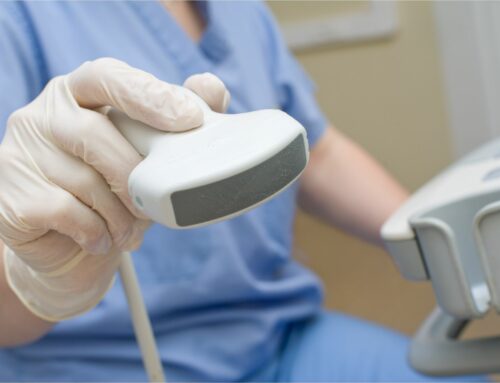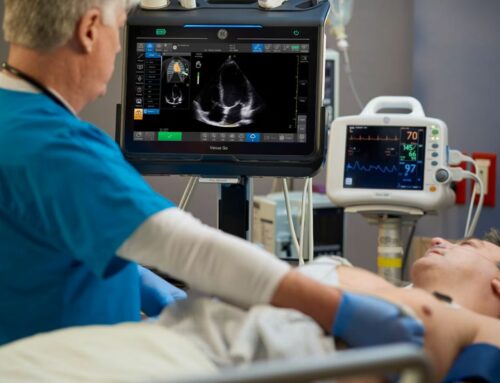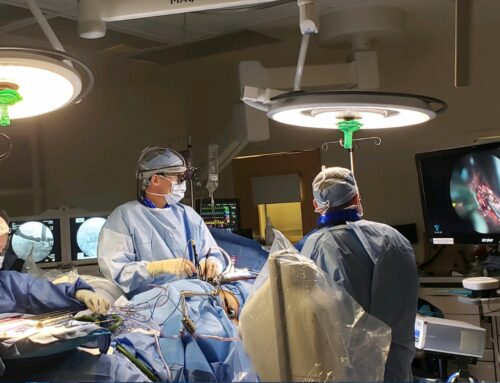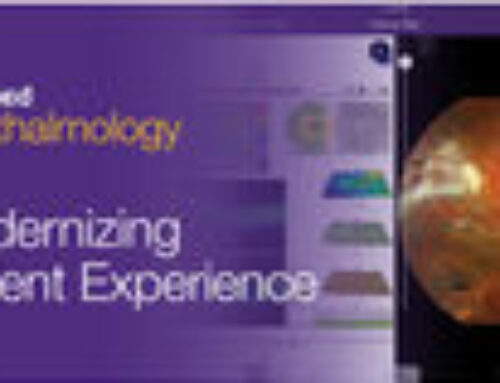2018 was a record year for the world ultrasound equipment market, with revenues increasing by 6.8%, tipping the market over the $7 billion mark for the first time. Despite the backdrop of global economic uncertainty, the ultrasound market is forecast to continue to grow relatively strongly in the coming years, with the following trends driving growth.
Trend 1 – New Users of Ultrasound
Over the years, the use of ultrasound has gradually expanded beyond radiology, cardiology and OB/GYN to a wide range of clinical specialities, including surgery, musculoskeletal and gastroenterology, to name a few, expanding the customer base and driving additional revenue growth. This trend started out in developed countries, but more recently it has spread to developing markets, particularly India and China, where speciality departments at larger hospitals now often have their own budgets to buy ultrasound.
Additionally, ultrasound is gaining acceptance in acute and primary care settings, both as a screening and diagnostic tool, as well as for procedure guidance. With the use of handheld ultrasound gaining pace (see Trend 4 below), this trend will accelerate in the coming years.

Trend 2 – New Uses of Ultrasound
As well as the growing customer base, the use of ultrasound with existing customers is expanding, typically as a lower-cost and/or radiation-free alternative to other imaging modalities, such as MRI and CT. The global shift to value-based care as a replacement to the traditional fee-for-service approach will support this trend.
For example, ultrasound is playing an increasingly important role as a screening tool for women with dense breast tissue. In acute care, ultrasound is increasing being used for lung imaging to diagnose conditions such as pleural effusion, pulmonary oedema and pneumothorax. In another example, the use of shear wave elastography is expanding beyond hepatology (e.g. liver fibrosis) to other body areas, including breast, prostate, thyroid and spleen. Musculoskeletal is another relatively untapped market for ultrasound, including orthopaedics, rheumatology and sport’s medicine.
Trend 3 – Emerging Markets
The ultrasound market in developed regions, such as Western Europe, North America and Japan, is largely saturated and the outlook is for low to mid single-digit growth. While these markets will continue to account for the lion’s share of the world market, developing markets continue to represent a growth opportunity. In 2019, fastest growth is forecast for Southeast Asia, Brazil, China and India. That said, ultrasound market growth is slowing in many of the emerging markets, particularly China, largely due to slowing global economic growth.
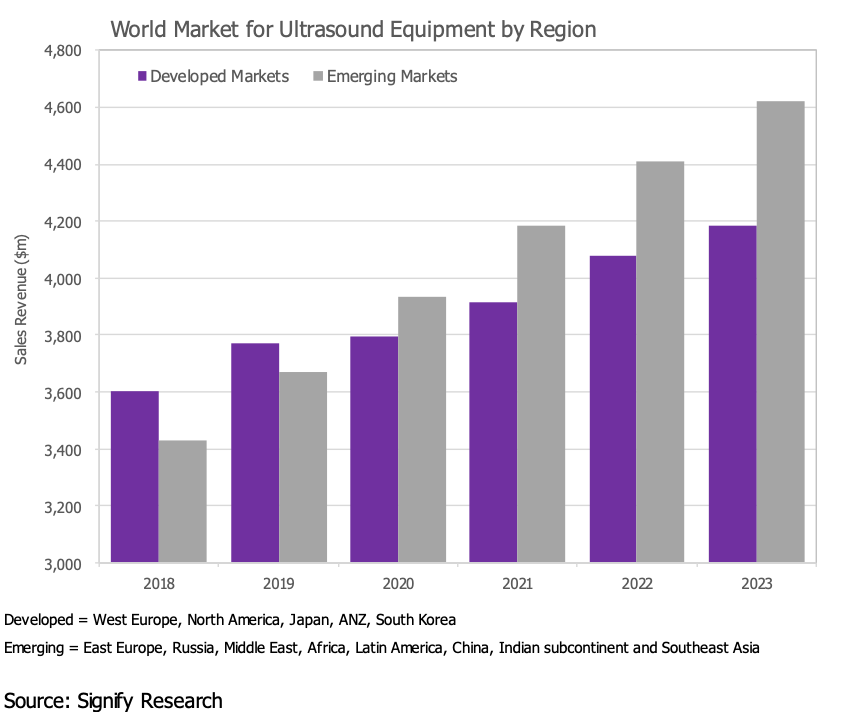
Trend 4 – Handheld Ultrasound
As we discussed in a previous insight (Handheld Ultrasound Market Poised for Next Wave of Growth), the handheld ultrasound market is growing rapidly, as the latest generation of ultra-portable devices gains acceptance among a diverse range of customer groups, from emergency medicine physicians and intensivists to internists and office-based specialists, and looking forward, primary care physicians. The expanding customer base, coupled with the increased availability of affordable handheld scanners, is forecast to boost global sales of handheld ultrasound by over 50% in 2019. By 2023, the global market for handheld ultrasound is forecast to exceed $400 million.
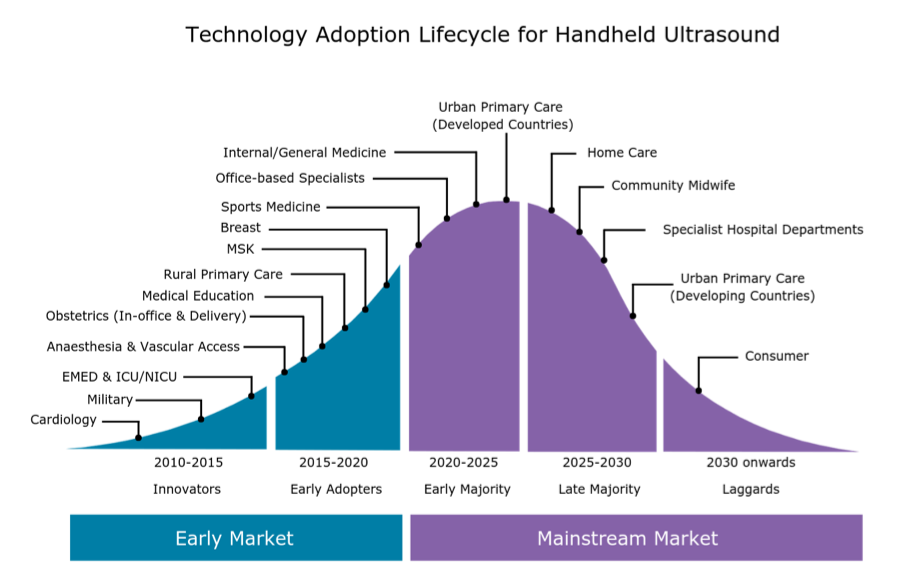
Trend 5 – Artificial Intelligence
Artificial intelligence (AI) will have a transformative impact on the market as it addresses some of the key limitations associated with ultrasound; namely, the shortage of trained sonographers and the relatively steep learning curve, high operator dependency both during image acquisition and interpretation, poor image quality for certain exam types and the relatively lengthy exam time compared with other modalities. The first wave of ultrasound AI applications are entering the market and are mainly for image optimisation (noise reduction) and automation of time consuming and repetitive tasks, such as anomaly detection, image labelling and feature quantification. However, the greatest impact of AI will be guided ultrasound (ultrasound navigation), which will provide real-time support during image acquisition (i.e. probe placement and anatomy detection). The first AI-enabled guided ultrasound systems are expected to be released in the second half of the year. These systems are expected to expand the user base by making ultrasound more accessible to novice users, particularly in acute and primary care.
Related Market Report
“World Market for Ultrasound Equipment – 2019 Edition” provides a data-centric analysis of current and projected demand for cart, compact and handheld ultrasound systems. It features analysis of 30 geographic markets, with breakdowns by clinical application and product mix. The report is based on a robust primary research method, including sales data reported by vendors of ultrasound equipment.
About Signify Research
Signify Research is an independent supplier of market intelligence and consultancy to the global healthcare technology industry. Our major coverage areas are Healthcare IT, Medical Imaging and Digital Health. Our clients include technology vendors, healthcare providers and payers, management consultants and investors. Signify Research is headquartered in Cranfield, UK. To find out more: enquiries@signifyresearch.net, T: +44 (0) 1234 436 150, www.signifyresearch.net
Content contributed by Signify Research


